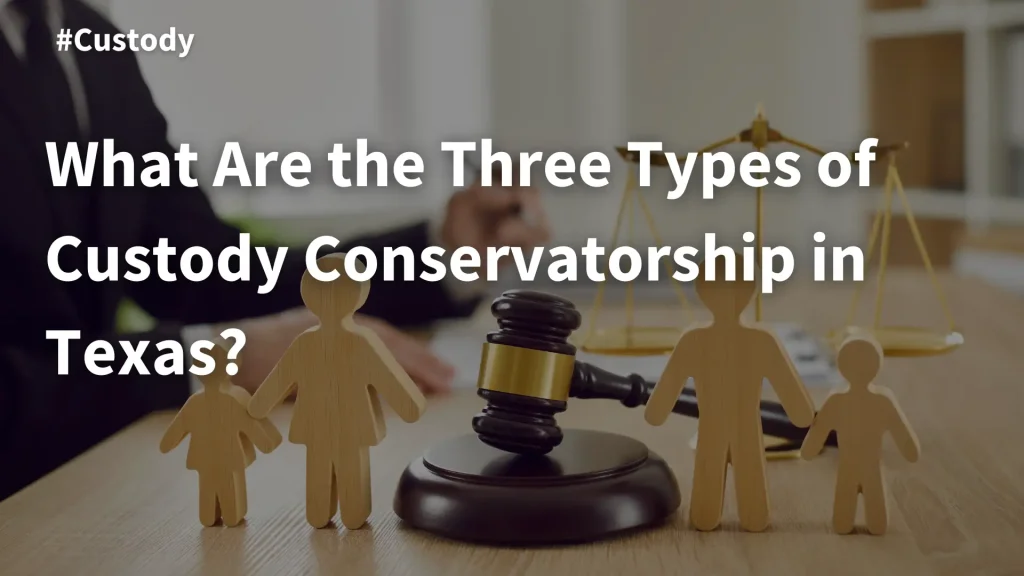 When dealing with family law matters in Texas, determining child custody is one of the most critical issues. In Texas, child custody is also known as conservatorship. Understanding what the 3 types of child custody in Texas are, how they differ, and what they mean for you and your child is essential for any parent who is going through the family law system. Texas law is unique, categorizing custody differently than many other states.
When dealing with family law matters in Texas, determining child custody is one of the most critical issues. In Texas, child custody is also known as conservatorship. Understanding what the 3 types of child custody in Texas are, how they differ, and what they mean for you and your child is essential for any parent who is going through the family law system. Texas law is unique, categorizing custody differently than many other states.
Understanding Conservatorship in Texas
Before explaining the different types of child custody, it’s important to understand what a conservatorship is. Conservatorship involves the legal rights and responsibilities a parent has regarding their child. This includes decisions about the child’s education, medical care, and religious upbringing.
The Three Types of Conservatorship in Texas
In Texas, the three primary types of conservatorship include:
Joint Managing Conservatorship (JMC)
Joint Managing Conservatorship is the most common form of conservatorship. In this arrangement, both parents share the rights and duties of raising their child. This does not necessarily mean that the child will split their time equally between both parents, but rather that both parents have a say in the significant decisions affecting the child’s life.
Some of the defining features of this type of conservatorship include:
- Shared Decision-Making – Both parents have a legal right to make important decisions about the child’s welfare, including educational, medical, and religious choices.
- Possession and Access – Although both parents share the decision-making responsibilities, it does not guarantee equal physical custody. One parent may still be the primary custodial parent with whom the child primarily resides, while the other parent has visitation rights.
- Child Support – In most cases, one parent must pay child support, even in a joint managing conservatorship arrangement.
The courts often favor Joint Managing Conservatorship because it encourages both parents to remain actively involved in their child’s life. It benefits the child’s emotional and psychological well-being when both parents contribute to their upbringing.
Sole Managing Conservatorship (SMC)
Sole Managing Conservatorship is a type of arrangement for custody where one parent gets the exclusive right to make most or all decisions regarding the child. The other parent may have limited rights or be completely excluded from decision-making. Some features of sole managing conservatorship that make it different from the other types of child custody include:
- Exclusive Decision-Making – The parent with Sole Managing Conservatorship has the sole authority to make decisions about the child’s education, medical care, and other essential aspects of their life.
- Limited Rights for the Other Parent – The non-custodial parent may still have visitation rights or “possession and access” in Texas. However, they will not have the same decision-making power.
- Child Support – The parent without custody usually has to provide child support to the parent with custody.
One parent may get Sole Managing Conservatorship in situations where the court believes that shared decision-making would not be in the child’s best interest. This could be due to a history of violence in the family, substance abuse, or other factors that could negatively impact the well-being of the child.
Possessory Conservatorship (PC)
Possessory Conservatorship refers to a non-custodial parent’s rights and duties regarding their child. While the parent with Sole Managing Conservatorship has the majority of the decision-making power, the parent with Possessory Conservatorship still has rights related to possession and access to the child. Features that set this type of conservatorship apart from the rest include:
- Visitation Rights – The parent with Possessory Conservatorship has the right to spend time with their child according to a visitation based on a court-established visitation schedule.
- Limited Decision-Making – While they do not have the same level of decision-making authority as the parent with Sole Managing Conservatorship, the possessory conservator can still make various decisions when the child is in their care.
Possessory Conservatorship ensures that the non-custodial parent remains a part of the child’s life, even if they do not have primary custody. It is an essential aspect of maintaining the parent-child relationship.
Choosing the Right Custody Arrangement
Deciding on the most appropriate type of conservatorship for your specific situation can be challenging. It is essential to focus on what is in the child’s best interest, which is the primary consideration for Texas courts. The court will evaluate various factors, including each parent’s ability to care for the child, the child’s needs, and any history of abuse or neglect.
Modifying Conservatorship Orders
Life circumstances can change, and what may have been the best custody arrangement at one time may no longer be suitable later on. In Texas, it is possible to modify a conservatorship order if there has been a significant change in circumstances. This could include changes in the child’s needs, a parent’s relocation, or issues related to the child’s safety.
To modify a conservatorship order, you must petition the court. The court will then assess whether the modification is in the child’s best interest. It is advisable to work with an experienced family law attorney when seeking to modify a conservatorship order. They can protect your rights throughout the process.
Working with an Experienced Family Law Attorney

An attorney can help you understand your rights, represent your interests in court, and ensure that any conservatorship arrangement is in the best interest of your child. They can also assist with modifying existing orders if your circumstances change.
Contact Our Austin Family Law Attorneys Today
Understanding the different types of child custody in Austin is crucial for any parent battling or negotiating a parenting plan. Whether you are seeking sole custody or exploring joint custody options, knowing what types of custody are there can help you make informed decisions that benefit your child. If you are facing a child custody issue, contact us online or call our Austin family law attorneys at Smith & Bledsoe Family Law through (512) 277-3166 to get started with a case evaluation. Our lawyers have the legal knowledge and proven track record to take on your case.
Related Posts:
AOP: How Do You Get a Court Ordered Paternity Test in Texas?